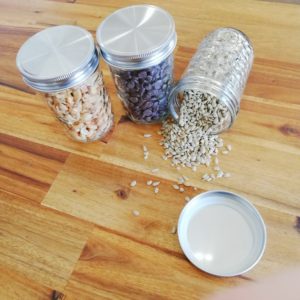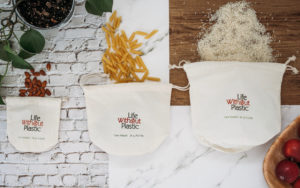Covid-19 disclaimer: we realize that many people are under different types of health restrictions and some bulk stores already have their products pre-bagged. As restrictions lift, we are seeing bulk stores start allowing customers to bring their own containers and begin to bag their products.
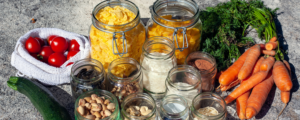
A few years ago, when someone mentioned “bulk shopping” I imagined Costco and buying obscene amounts of toothpaste that was on sale. I used to LOVE that kind of bulk shopping. I had my hallway closet packed full of cleaning supplies, non-perishable foods and personal care items that were on sale.
Now when you look in my hall closet you will not find any “stocking up items” because I no longer bulk shop that way.
Today we are talking about, in my opinion, the good kind of bulk shopping. The kind of bulk shopping that cuts down on plastic waste, food waste and overconsumption.
Bulk shopping can be daunting for first timers so if you are feeling a bit unsure of how to actually bulk shop, continue reading because we are going to be giving you some tips and help prepare you for your first bulk shopping experience!
What is bulk shopping?
Bulk shopping is buying food based on weight, not pre-packed amounts. You can buy as little or as much as you need. Which is one of the pros of bulk shopping. How many times have you bought an ingredient for a new recipe and never use it again and end up throwing it out or it goes bad?
With bulk shopping you buy what you need, which creates less food waste and you can bring your own containers, which creates less plastic waste!
When you enter the bulk food store or aisle for the first time you may run into a few terms you haven’t heard of before:
Tare Weight: the weight of your container or bag when it is empty. If you are using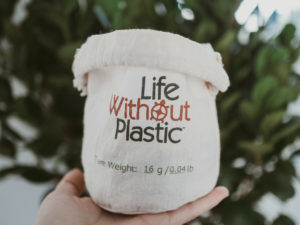 jars you will want to weigh it empty and write the Tare Weight on the top of the lid. That way when you go to pay, the cashier will subtract the weight of the container when they weigh the food.
jars you will want to weigh it empty and write the Tare Weight on the top of the lid. That way when you go to pay, the cashier will subtract the weight of the container when they weigh the food.
PLU (Product Look Up): Different stores use different ways to identify their products at the check-out. Some stores will have a PLU that you will want to write on the top of your jar or on the slip of paper.

Other stores will want the product name or bin number, which you will want to write on the top of your lid or slip of paper.
If you are confused by what you need to write down, ask someone. It is so much easier for the cashier if you collect all the information you need as you shop rather then getting to the checkout and having to go back!
Why bulk shop?
As mentioned above, bulk shopping creates minimal food waste because you are only buying what you need.
Shopping in bulk helps cut your plastic consumption if you bring your own jars and bags.
Many times bulk shopping offers healthier options than the pre-packaged foods in the grocery store. Most pre-packaged foods contain preservatives to extend their shelf life; unlike bulk foods, which have a shorter shelf life, but most of the time do not contain any additives.
Tools for Bulk Shopping
There are a variety of options for filling up on bulk foods. My favorite containers to use are mason jars because you do not have to move your ingredients to another container when you get home. Mason jars are also inexpensive, easily available, and can be used in a variety of different ways. And you also can write all the information you need on the lids so everything is together when you get to the checkout. Our team often swaps out the lids that come with the jars because they can contain BPA on the inner lining and instead opts for stainless steel lids. These regular and wide mouth stainless steel lids are leak-proof, rust-proof, and BPA-free.
Another one of our team’s favorites are the organic cotton bulks bags. There are so many on the market, but we felt there was room for improvement so we thought about the bulk shopping process from beginning to end and designed a line of bags that are:
- Made from 100% organic cotton
- Flat bottoms, so they sit upright, are easy to fill and don’t fall over
- Double drawstrings so they tie and close tightly
- Tare weight printed on the bag for easy checkouts
- Wide openings to easily fill
- Lightweight and easy to keep in your bag when on the go
- The large bag has a double lining for finer items like flours and sugars
If you’ve been bulk shopping before, you may be familiar with the feeling of nervousness as the jars in your bag clank around. Feel at ease with a bag made specifically for bulk shopping like this one from Life Without Plastic which is made with six thick interior pockets to protect your jars. We also use this organic cotton bulk shopping tote for all kinds of toting, great for separating wine bottles, baguettes, or anything on-the-go.
How to bulk shop?
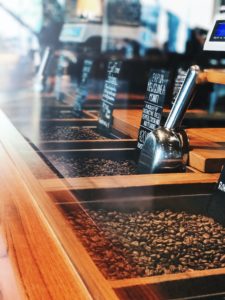
Marker
Jars and/or bags
Grocery list
With bulk shopping it is important that you have a plan. I love meal planning. Sitting down at the end of the week to start planning what we will be having for our meals the next week helps me think intentionally about our family meals. We do not necessary plan what days we will eat what but I do plan for lunches, suppers and snacks.
When you get to the store, if you are using jars you will need to weigh your jar first and write the Tare Weight on the top. Most bags now have the Tare Weight on the tag, if not, you will also need to weigh your bags.
You will need a marker to write down the Tare Weight and product number on the top of your lid or on a piece of paper (the stores provides these) so that the cashier knows how much to take off when they weight your item.
This is another reason why I love using jars. You can bring a white board marker and write the Tare Weight and the product number on the lid. It is easily wiped off. If I am using bags, I will bring kraft tape and put it on my bags and write everything I need on the tape (see picture below).
Tips:
-Go at less busy times (early morning or late evening).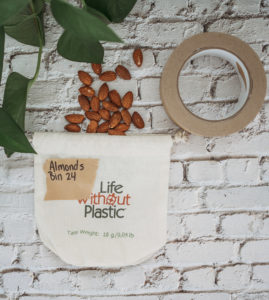
-If possible, leave the kids and/or furry friends at home the first few times.
-The first time you go, maybe start with getting only a few items.
-If you’re getting a lot, bring a rolling basket or a large tote with pockets.
-If you are using bags, I like to bring kraft tape so I can write all the information straight onto the bag (see picture).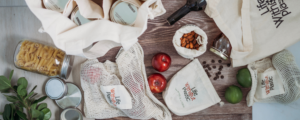
Author: Sarah Atherton, LWP Content Creator

